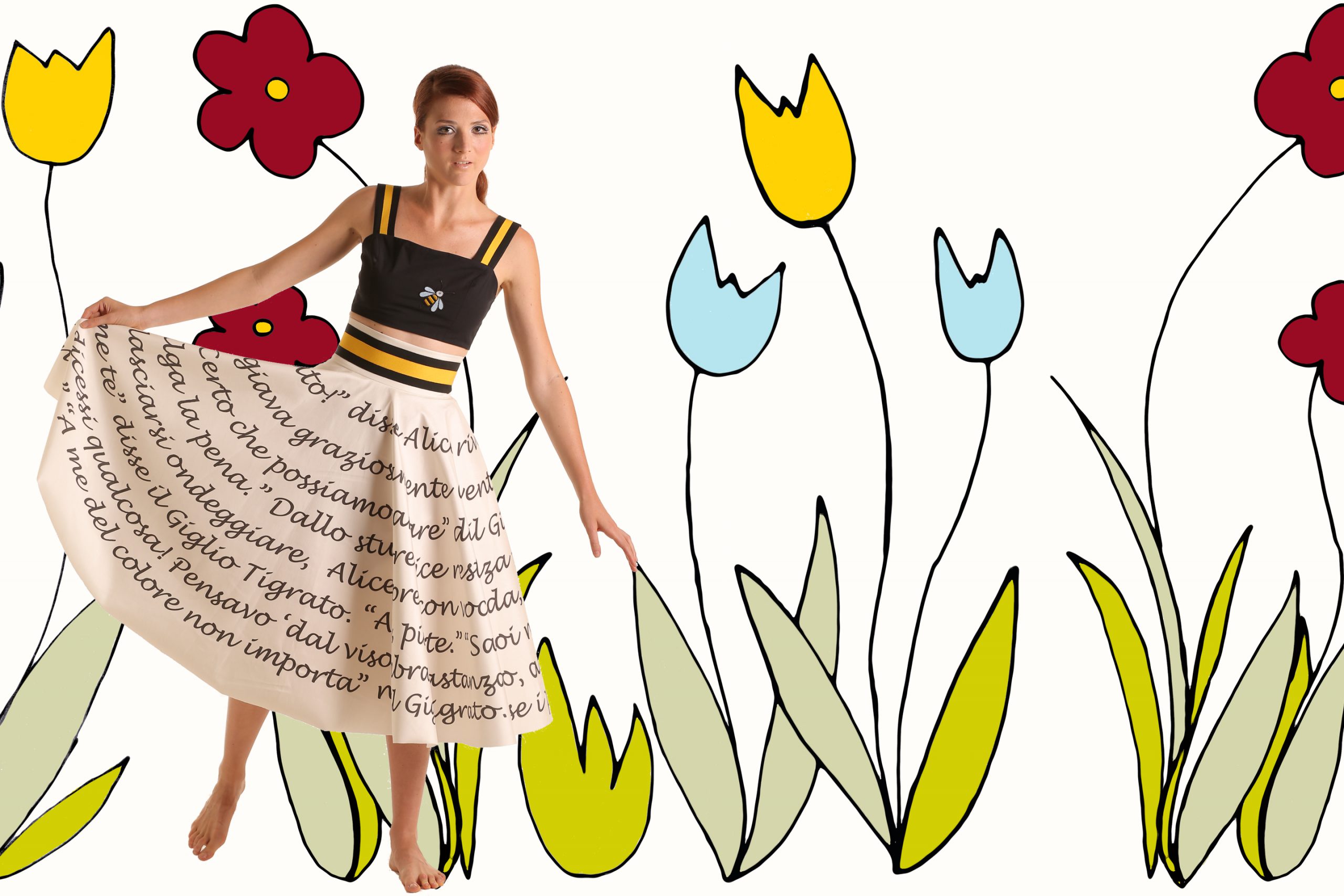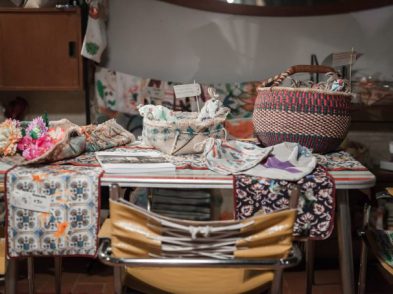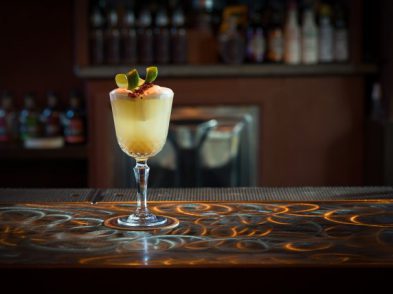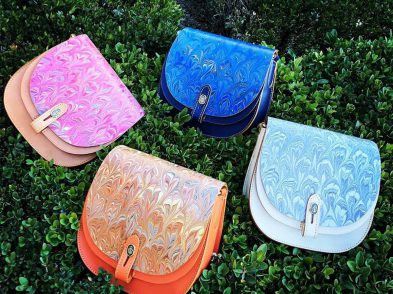Cecilia Arpa, an upcoming Tuscan designer, sits with her legs crossed under the table, her navy wide leg trousers pulled up slightly to reveal a white Converse All Star sneaker with a hidden wedge. A red scarf is tied around her neck and matches a red and white striped shirt underneath a sheer white jacket of her own design. Her hair is the perfectly moussed equivalent of Anna Wintour’s famous banged bob and she sports little jewelry except a navy watch and a plain gold wedding band. As she patiently waits to introduce herself, she uncrosses her legs and straightens her glasses. She then sketches out her emerging career.
Her background
Arpa explained that she has been a fashion fanatic since she was young, growing up in Montecatini. While she initially said she wasn’t sure how it started she momentarily pulled out a bound book of old Les Jardins des Modes, a French fashion magazine, and explained that she used to read it while her mother made lace, embroidered, and made dresses. It became clear exactly how her obsession started.
The pages of the magazine featured refined and polished looks: neck ties (much like Arpa’s red one), scarves and gloves. A red blazer. A tan trench coat. Brigitte Bardot as a young model. It was a how-to guide on classic dressing and Arpa seemed to have embraced it in its entirety. As a result, or maybe a coincidence, Arpa loved large skirts and Audrey Hepburn-esque trousers while girls her age were wearing hot pants and jeans. Instead of being influenced by the fashion of the moment, she cultivated an individual style. She explained, quite simply, “fashion has to be personal. It has to be your own way.”
Her studies
Apra didn’t immediately become a designer. She excelled in school and studied engineering, earning a Bachelor’s degree and a PhD before going to work in her father’s concrete factory. After working there for a while she found herself unable to continue due to personal matters. Suddenly at home for long periods of time, Arpa found herself on the Internet, immersed in the world of online fashion magazines and blogs. She eventually found The Satorialist by famous street-style photographer Scott Schuman and found it deeply inspiring. Not long after she started her own blog.
The blog
Named “Modeskine” after the popular notebook brand Moleskine, Arpa’s blog aimed to be a fashion notebook. There she explored her creative self, inventing an alter ego named Celia and drawing cartoons of her. When she told people that she was a style blogger, however, she realized that her personal style needed to come through in her website somehow. As she was too shy to post pictures of herself, she would draw Celia in the outfits that she was wearing and post those instead, opting to also post street style photos of people that she found and admired, à la Scott Schuman. While her blog grew, she knew that her eventual aim was become a fashion designer.
Apra started to make clothes for several shops with good high quality fabrics and a particular design but it was a small production and not a complete collection. While only a few shops picked it up and the design just included a few pieces, it was a start.
How she began
Some time later Arpa asked a woman who worked in fashion PR for an opinion on her clothing. To put it bluntly, she asked her if she believed that Arpa could start her own line. Every talented artist hopes for a glowing review from critics, but Arpa received a harsh piece of advice. The woman told her to start from the beginning. More specifically, she said, “you have to think that in this moment there are a lot of clothes, too many clothes, but there are not many ideas. If you want to start your own brand you need to put your own ideas and creativity into it. Ideas can live on. Simple jackets and trousers – you can’t do that, there are too many people who do it already. Also, you can’t do clothes in an artisanal way, you need to do it in a professional way and have someone to produce it. You need to come up with the complete idea of what you want and have someone make it. Don’t be afraid to show strong things.”
Following this advice Arpa created her first collection. She then returned to ask her friend and this time she was told, “it’s good, you can produce it.” Arpa’s eponymous clothing label was born!
Her first collection
Based on words and flowers, her first collection included a combination of inspiration drawn from a number of sources. She pulled up her moodboard, which included The Yellow Kid (a cartoon character that sported a yellow dress covered in text), Queen Elizabeth II, Twiggy, Arpa’s own drawings, and Kendall Jenner on the cover of Dazed magazine. It felt very mod, very ‘60s. Sure enough, the collection was very similar, emitting both mod and modern vibes. Arpa incorporated a number of various quotes about flowers in her pieces, including my favorite, “Florals? For Spring? Groundbreaking,” from the fashion film The Devil Wears Prada, printed on the back of a varsity jacket in a soft powder blue.
Her influences
Not all of Apra’s quotes were pop culture based. Many were drawn from literature and from her background in mathematics, drawing inspiration from Fibonacci, a well-known mathematician in the 16th century, most famous for his golden spiral. Arpa incorporated this law found in nature into her prints, such as in a soon-to-be skirt featuring a print based on the dimensions of the golden spiral and constructed with a single piece of fabric. She also cited Möbius, another mathematician, as an inspiration and produced a scarf as one of his famous infinite Möbius rings. As a whole, the collection seems to be a unifying take on a whimsical yet intellectual pairing.
Inspirations
When asked, “where is your inspiration from?”, Apra stated outright that she looks at Enrico Coveri and Jeremy Scott, and that Moschino has always been a label that she admires because it’s classical, full of color, and can be paired in many ways. Yet it seems that she will not be emulating her idols, instead choosing to put ideas before aesthetics, just as she was advised to do. The result, of course, is both aesthetically astounding and intellectually stimulating.
Cecilia and Florence
Arpa explained that Florence has exerted a great influence on her work in three separate stages. First, as a child, she was taken very often by her artistic mother to the Uffizi and other famous museums as part of her aesthetic education. As an adolescent she herself haunted the vintage markets then at San Lorenzo for the large collections of dresses and accessories from the 1940s which were for sale. The floral dresses and feathers on display especially influenced her later design sense.
Finally, as an adult and emerging designer of womenswear, she has explored the outer hinterlands around Florence where artisans and craftspeople specialize in printing and stamping colors on textiles. She finds supplies of materials to buy and to inspire herself. Cecilia Arpa is a serious researcher of fashion elements and finds the area outside the city an ideal venue for discovering trends and fabrics integral to her work.
Pitti Uomo
Moreover, Arpa is interested in the world of Pitti Immagine. While she does not produce menswear or attend Pitti Uomo, she is currently engaged in a joint project to link children’s wear with educational play and games. The project is working on plans to mix pedagogical games with clothes for children that will be both instructive and aesthetic. Florence has always had much to offer to her imagination!
The future
Finally, when asked where she sees her line going in the future, Arpa lit up. She asked us if we wanted to see her sketches for the upcoming line. She pulled up sketches revealing fish, starfish, and fishing nets in a color scheme of red and blue. It was even more whimsical than the current collection and truly original.
Cecilia Arpa may just be the next Jeremy Scott, except instead of Barbie, she’ll be using Baudelaire.
About Fashion in Florence
In May-June 2017 ISI (International Studies Institute of Florence) will offer for the third time an innovative class in Fashion Communication for non-specialized students in design. Emphasis will be on analysis of leading fashion media critics, commentators, bloggers and influencers. During the last edition of the course students had the opportunity to visit Pitti Uomo fashion trade-fair and write their reports and blogs including one-on-one interviews with leading young figures in Fashion in Florence. Professor Emeritus Mark Bernheim headed the team, which included fashion commentator Alessandro Masetti.






